Long Bean Trial — 2007
Garden Help > Vegetables > Beans
Summary
We compared 12 varieties of long beans, Vigna unguiculata, to determine which ones have the best production and the best flavor for growing here in Santa Clara County. Chinese Green Noodle was the most productive variety by far and was the favorite in the first tasting for its very tender, mild pods. Chinese Red Noodle was a favorite for those who like beans with a richer flavor and a firmer texture and was a good producer. All activities were conducted at out Nine Palms growing facility.
Soil preparation
The plot had previously been used for a raspberry trial. In May we finished removing the raspberries and rototilled in four inches of compost.
Arbor
We created an arbor structure for the beans to climb by bending 16-foot lengths of five-foot wide concrete reinforcing wire into an arch and lashing them to eight-foot posts that had been driven one and one-half feet into the ground. The arch is 4 feet wide, 7 feet high in the center, and 35 feet long. The one-foot wide planting beds are mounded slightly, about six inches higher than the center of the pathway. The concrete reinforcing wire has a 6-inch mesh.
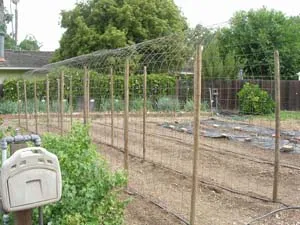
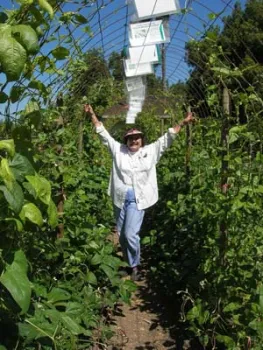
Seeding and transplanting
We planted the beans directly into the ground on June 1, two beans per hole, six inches apart, and thinned them after two weeks to one seedling every six inches. There were eight vines of each variety, four vines on each side of the arbor so they could grow up to the center and meet. There was a one-foot gap between varieties.
The planting order was the same on both sides of the arbor. We attempted to alternate the pod colors for ease of harvesting, although the pod colors weren't known for all varieties. From south to north (front to back), it was:
Taiwan Black (light green)
Chinese Mosaic (lavender-pink)
Black Stripe Seed (light green)
Chinese Red Noodle (deep red)
Thai Red Seeded (green)
Canton White Pod (light green)
Kaoshiung (dark green)
Red Stripe Seed (light green)
White Seed (light green)
Surinam Asparagus Bean (green)
Red-Seeded Asparagus Bean (deep red)
Chinese Green Noodle (bright green)
Watering
Irrigation was set to 45 minutes, three times a week.
Fertilization and pesticides
No additional fertilizer was used. No pesticides were used.
Harvesting and observations
Harvesting began on August 7 with Chinese Mosaic and Chinese Green Noodle. Our last harvest was September 28, and the vines were removed on October 2. The biggest producer, by far, was Chinese Green Noodle, followed by Chinese Mosaic and Chinese Red Noodle.
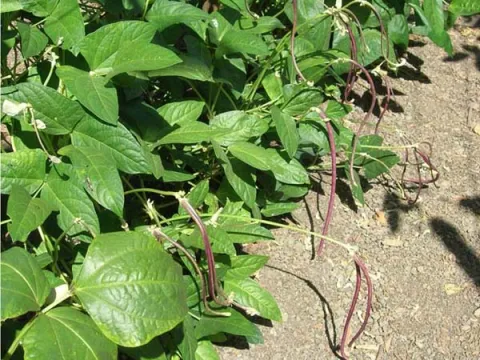
Long beans mature quickly and need to be picked every few days so they don’t become over mature and tough. In general, they should be picked while still slender, before they get puffy and the seeds become visible. Thai Red Seeded and White Seed were two varieties that could be allowed to get a little fatter and meatier than the others while still remaining tender.
We harvested through Sept 28, although at that point most varieties were producing a few ounces or less. Only Canton White Pod (10 oz) and Thai Red Seeded (13 oz) were still producing more than minimal amounts that final day.
| Variety | Total production in ounces | First harvest | Last harvest | Pod color | Description | Source |
|---|---|---|---|---|---|---|
| Black Stripe Seed | 23.5 | 4-Sep | 28-Sep | Light green | Very branching at bottom, vigorous growth | Evergreen |
| Canton White Pod | 58.5 | 4-Sep | 28-Sep | Light green | Lighter green leaves, short beans | Evergreen |
| Chinese Green Noodle | 212.5 | 7-Aug | 28-Sep | Bright green | Vigorous growth, big producer | Baker Creek Heirloom Seeds |
| Chinese Mosaic | 135.5 | 7-Aug | 21-Sep | Lavender-pink | Early production on lower branching vines | Baker Creek Heirloom Seeds |
| Chinese Red Noodle | 134.5 | 24-Aug | 25-Sep | Deep red | Vigorous, dark green leaves | Baker Creek Heirloom Seeds |
| Kaoshiung | 0.5 | 28-Sep | 28-Sep | Dark green | Short vines, never really produced, mosaic virus | Evergreen |
| Red Stripe Seed | 44.5 | 31-Aug | 28-Sep | Light green | Signs of mosaic virus | Evergreen |
| Red-Seeded Asparagus Bean | 82.5 | 21-Aug | 28-Sep | Deep red | Short and concentrated production | Baker Creek Heirloom Seeds |
| Surinam Asparagus Bean | 58 | 24-Aug | 28-Sep | Green | Curly beans | Baker Creek Heirloom Seeds |
| Taiwan Black | 84.25 | 24-Aug | 28-Sep | Light green | Very long beans | Baker Creek Heirloom Seeds |
| Thai Red Seeded | 82.75 | 21-Aug | 28-Sep | Green | Very vigorous vines and dense foliage | Baker Creek Heirloom Seeds |
| White Seed | 62.25 | 28-Aug | 28-Sep | Light green | Lighter green leaves, signs of mosaic virus | Evergreen |
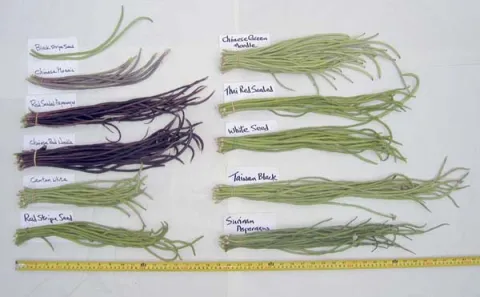
Tasting
We conducted two tastings. The first one was on Aug 24 with the five varieties that were producing at the time (Chinese Green Noodle, Chinese Mosaic, Chinese Red Noodle, Red-Seeded Asparagus, and Thai Red-Seeded). The second tasting was on September 18, with all varieties except Kaoshiung, which only produced one pod at the very end. For both events, Jean individually stir-fried samples of each of the varieties in a hot wok with oil, a little salt, and some water to steam. People were welcome to taste the beans raw as well if they wanted to.
| Variety | First tasting votes | Second tasting votes | Comments |
|---|---|---|---|
| Black Stripe Seed | None to taste | 11 | Sweeter than others |
| Canton White Pod | None to taste | 3 | Nice flavor |
| Chinese Green Noodle | 11 | 0 | Very tender, mild, good taste. Very similar to the long bean widely available in San Francisco Chinatown, perhaps due to its high yield. (For the second tasting, this variety was past its prime.) |
| Chinese Mosaic | 1 | 2 | Turns dark green when cooked, nutty flavor, firmer texture, not sweet |
| Chinese Red Noodle | 7 | 4 | Rich, deep flavors, chewy. But some people disliked the firmer texture, calling it tough. |
| Kaoshiung | None to taste | None to taste | |
| Red Stripe Seed | None to taste | 6 | Deep flavor, meaty, lingering flavor |
| Red-Seeded Asparagus Bean | 6 | 3 | Almost as tender as Green Noodle, crisp, nutty |
| Surinam Asparagus Bean | None to taste | 5 | Asparagus-like flavor when raw, grassy, a little tough |
| Taiwan Black | None to taste | 0 | A touch bitter, grassy, not meaty, tender after cooking |
| Thai Red Seeded | 0 | 2 | Heavy flavor, not as sweet as others, very tasty, sweet, meaty. Can be picked at a larger diameter, resulting in sweeter, meatier beans. |
| White Seed | None to taste | 1 | Very sweet, meaty if allowed to develop, very tender |
Pests & diseases
Ants were present on the vines and flowers. They did not appear to be causing any damage but were merely visiting the extrafloral nectaries present on the flowers.
Red Stripe Seed, White Seed, and Kaoshiung varieties showed signs of bean mosaic virus from the start, so I suspect the seed was infected. We didn’t do anything, although in retrospect perhaps we should have taken out the infected vines so the virus wouldn’t be spread to any others. We didn’t save seed from any of the varieties due to the presence of the virus in the plot.
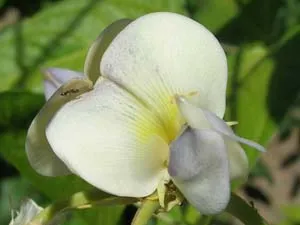
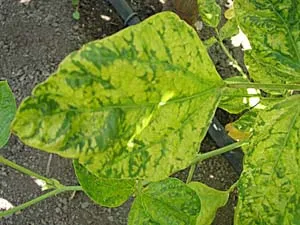
Conclusion
Chinese Green Noodle was the most productive variety by far and was the favorite in the first tasting for its very tender, mild pods. Chinese Red Noodle was a favorite for those who like beans with a richer flavor and a firmer texture and was a good producer. Black Stripe Seed was rated highly for flavor but was a poor producer.
Lead: Karen Schaffer
Team members: Jean Lee, Ken Lee, plus assistance from many Nine Palms regulars
